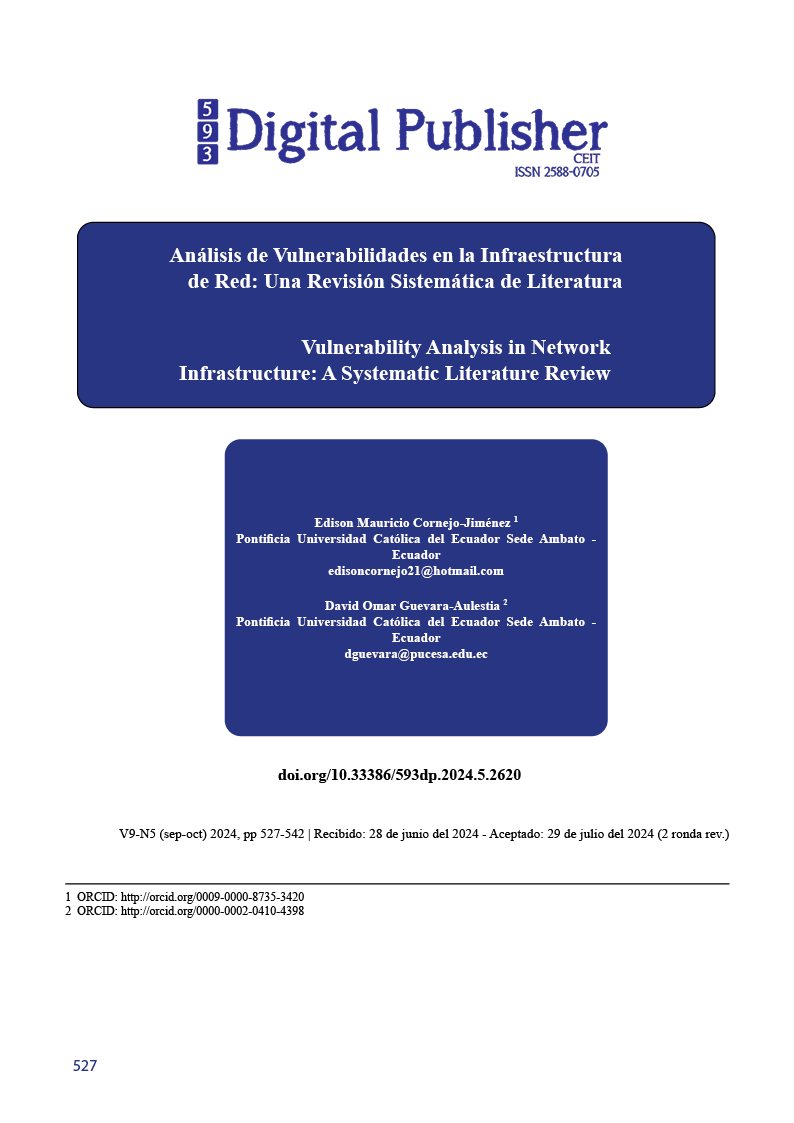Análisis de Vulnerabilidades en la Infraestructura de Red: Una Revisión Sistemática de Literatura
Contenido principal del artículo
Resumen
Con el avance de la era digital, las organizaciones han experimentado una creciente dependencia de las tecnologías de la información y comunicación. Este aumento en la conectividad ha llevado consigo un incremento en los ataques cibernéticos a las infraestructuras de red, poniendo en peligro activos y datos críticos. En el presente artículo se desarrolla una revisión sistemática de literatura sobre el análisis de vulnerabilidades de infraestructura de red en los últimos 10 años, empleado las bases de datos IEEE, SCOPUS y Redalyc para el proceso de revisión. Se determinó que el método más utilizado fue el análisis de tráfico, y la técnica más empleada el fuzzing de protocolos de red. Predominó el análisis de vulnerabilidades sobre protocolos de red y, por tanto, el análisis del componente de servicio. El análisis de vulnerabilidades en infraestructuras de red es un ámbito de investigación que posee escasa documentación científica publicada en los últimos 10 años, requiriendo especial atención en el ámbito industrial, así como una mayor investigación en áreas emergentes como el Internet de las cosas, la inteligencia artificial y la computación en la nube.
Descargas
Detalles del artículo

Esta obra está bajo una licencia internacional Creative Commons Atribución-NoComercial-CompartirIgual 4.0.
1. Derechos de autor
Las obras que se publican en 593 Digital Publisher CEIT están sujetas a los siguientes términos:
1.1. 593 Digital Publisher CEIT, conserva los derechos patrimoniales (copyright) de las obras publicadas, favorece y permite la reutilización de las mismas bajo la licencia Licencia Creative Commons 4.0 de Reconocimiento-NoComercial-CompartirIgual 4.0, por lo cual se pueden copiar, usar, difundir, transmitir y exponer públicamente, siempre que:
1.1.a. Se cite la autoría y fuente original de su publicación (revista, editorial, URL).
1.1.b. No se usen para fines comerciales u onerosos.
1.1.c. Se mencione la existencia y especificaciones de esta licencia de uso.
Citas
Akpinar, K. O., & Ozcelik, I. (2019). Analysis of Machine Learning Methods in EtherCAT-Based Anomaly Detection. IEEE Access, 7, 184365-184374. Scopus. https://doi.org/10.1109/ACCESS.2019.2960497
Alabady, S. A., Al-Turjman, F., & Din, S. (2020). A Novel Security Model for Cooperative Virtual Networks in the IoT Era. International Journal of Parallel Programming, 48(2), 280-295. Scopus. https://doi.org/10.1007/s10766-018-0580-z
Alarood, A., Ibrahim, A., & Alsubaei, F. (2023). Attacks Notification of Differentiated Services Code Point (DSCP) Values Modifications. IEEE Access, 11, 126950-126966. https://doi.org/10.1109/ACCESS.2023.3332119
Alhaidary, M., Rahman, S. M. M., Zakariah, M., Shamim Hossain, M., Alamri, A., Haque, M. S. M., & Gupta, B. B. (2018). Vulnerability Analysis for the Authentication Protocols in Trusted Computing Platforms and a Proposed Enhancement of the OffPAD Protocol. IEEE Access, 6, 6071-6081. Scopus. https://doi.org/10.1109/ACCESS.2017.2789301
Álvarez, Y., Leguizamón, M., & Londoño, T. (2021). Risks and security solutions existing in the Internet of things (IoT) in relation to Big Data. Ingeniería y Competitividad, 23, 1-13.
Astudillo, C., Carvajal, F., Carvallo, J., Crespo, E., Orellana, M., & Vintimilla, R. (2018). Acometer contra un ERP con Software Libre. Enfoque UTE, 9, 138-148.
Brereton, P., Kitchenham, B. A., Budgen, D., Turner, M., & Khalil, M. (2007). Lessons from applying the systematic literature review process within the software engineering domain. Journal of Systems and Software, 80(4), 571-583. https://doi.org/10.1016/j.jss.2006.07.009
CISCO. (2023). What Is Network Infrastructure? Cisco. https://www.cisco.com/c/en/us/solutions/enterprise-networks/what-is-network-infrastructure.html
Codina, L. (2019, octubre 30). Scopus: Caracterización y guía de uso avanzado · Preparación, búsqueda y exportación de resultados. Lluís Codina. https://www.lluiscodina.com/scopus-analisis-guia-utilizacion/
Cueva, M., & Alvarado, D. (2017). Análisis de Certificados SSL/TLS gratuitos y su implementación como Mecanismo de seguridad en Servidores de Aplicación. Enfoque UTE, 8, 273-286.
Deola, E. (2023, febrero 4). Ataque Wanna Cry: La importancia de disponer de sistemas de seguridad actualizados. FlashStart. https://flashstart.com/es/el-ataque-wannacry-de-2017/
Fortra. (2022). Qué es el escaneo de vulnerabilidades y cómo funciona | Fortra Blog. https://www.fortra.com/es/blog/escaneo-vulnerabilidades
Gábor, L., & Sándor, R. (2014). Improving the Performance and Security of the TOTD DNS64 Implementation. Journal of Computer Science and Technology, 14, 9-15.
IBM Security. (2023). Cost of a Data Breach Report 2023. https://www.ibm.com/downloads/cas/E3G5JMBP
Ierardi, C., Orihuela, D. L., Jurado, I., Rodríguez, Á., & Tapia, A. (2017). Revisión sistemática de la literatura en ingeniería de sistemas. Caso práctico: Técnicas de estimación distribuida de sistemas ciberfísicos. Actas de las XXXVIII Jornadas de Automática, 2017, ISBN 978-84-16664-74-0, págs. 84-91, 84-91. https://dialnet.unirioja.es/servlet/articulo?codigo=6591559
Jacklin, B. (2024, febrero 21). AI Technology is Invaluable for Cybersecurity. Https://Www.Smartdatacollective.Com/. https://www.smartdatacollective.com/ai-technology-is-invaluable-for-cybersecurity/
Kholidy, H. (2022). Multi‐layer attack graph analysis in the 5g edge network using a dynamic hexagonal fuzzy method. Sensors, 22(1). Scopus. https://doi.org/10.3390/s22010009
Kim, H., Hwang, E., Kim, D., Cho, J., Moore, T. J., Nelson, F. F., & Lim, H. (2023). Time-Based Moving Target Defense Using Bayesian Attack Graph Analysis. IEEE Access, 1-1. Scopus. https://doi.org/10.1109/ACCESS.2023.3269018
Kubecka, M. (2020). Practical Cybersecurity Architecture: A guide to creating and implementing robust designs for cybersecurity architects (Packt Publishing).
Kumar, B. K., Raj, N., Dhivvya, J., & Muralidharan, D. (2019). Fixing Network Security Vulnerabilities in Local Area Network. 2019 3rd International Conference on Trends in Electronics and Informatics (ICOEI), 1349-1354. https://doi.org/10.1109/ICOEI.2019.8862634
Li, J., Zhao, B., & Zhang, C. (2018). Fuzzing: A survey. Cybersecurity, 1(1), 6. https://doi.org/10.1186/s42400-018-0002-y
Limones, E. (2022, septiembre 23). Análisis de vulnerabilidades informáticas [Blog]. OpenWebinars.net. https://openwebinars.net/blog/analisis-de-vulnerabilidades-informaticas/
Luo, J., Shan, C., Cai, J., & Liu, Y. (2018). IoT application-layer protocol vulnerability detection using reverse engineering. Symmetry, 10(11). Scopus. https://doi.org/10.3390/sym10110561
Marcillo, M. P., Marcillo, J. C., Ortiz, M. M., & Mero, E. A. (2021). Análisis de las Herramientas y Técnicas utilizadas en prueba de penetración para la detección de vulnerabilidades en aplicaciones web. UNESUM - Ciencias. Revista Científica Multidisciplinaria, 5(1), Article 1. https://doi.org/10.47230/unesum-ciencias.v5.n3.2021.316
Milani, S., & Chatzigiannakis, I. (2021). Design, analysis, and experimental evaluation of a new secure rejoin mechanism for lorawan using elliptic-curve cryptography. Journal of Sensor and Actuator Networks, 10(2). Scopus. https://doi.org/10.3390/JSAN10020036
Molina, Y., & Orozco, L. G. (2020). Vulnerabilidades de los Sistemas de Información: Una revisión. https://dspace.tdea.edu.co/handle/tdea/1398
Navarro, G. (2011). Introducción a las vulnerabilidades. Universitat Oberta de Catalunya.
Nebbione, G., & Calzarossa, M. (2023). A Methodological Framework for AI-Assisted Security Assessments of Active Directory Environments. IEEE Access, 11, 15119-15130. Scopus. https://doi.org/10.1109/ACCESS.2023.3244490
Pando, F. (2023, junio 22). Haz un análisis de vulnerabilidades para tu empresa; cajas blanca y negra. IT Masters Mag. https://www.itmastersmag.com/noticias-analisis/analisis-de-vulnerabilidades-cual-es-su-importancia/
Pastorino, C. (2017). Aclarando KRACK Attack, la vulnerabilidad descubierta en WPA2. Welivesecurity. https://www.welivesecurity.com/la-es/2017/10/27/aclarando-krack-attack-wpa2/
Peng, Y. (2023). Research on the Technology of Computer Network Security Protection. Journal of Applied Data Sciences, 4(1), Article 1. https://doi.org/10.47738/jads.v4i1.80
Ramírez, G. A. (2023). Seguridad en desarrollo web: Mejores prácticas para proteger aplicaciones y datos. Dominio de las Ciencias, 9(3), Article 3. https://doi.org/10.23857/dc.v9i3.3552
Rouse, M. (2023, octubre 30). Network Infrastructure. Techopedia. https://www.techopedia.com/definition/16955/network-infrastructure
Sánchez, F., Martínez, J. E., & Téllez, A. (2022). La seguridad en el ciberespacio desde una perspectiva sociocultural. methaodos.revista de ciencias sociales, 10(2), Article 2. https://doi.org/10.17502/mrcs.v10i2.577
Shastry, B., Leutner, M., Fiebig, T., Thimmaraju, K., Yamaguchi, F., Rieck, K., Schmid, S., Seifert, J., & Feldmann, A. (2017). Static Program Analysis as a Fuzzing Aid. En M. Polychronakis, M. Antonakakis, M. Dacier, & M. Bailey (Eds.), Lect. Notes Comput. Sci.: Vol. 10453 LNCS (pp. 26-47). Springer Verlag; Scopus. https://doi.org/10.1007/978-3-319-66332-6_2
SolarWinds. (2023). What Is Network Infrastructure? All About Network Infrastructure - IT Glossary. https://www.solarwinds.com/resources/it-glossary/network-infrastructure
Zhang, Z., Zhang, H., Zhao, J., & Yin, Y. (2023). A Survey on the Development of Network Protocol Fuzzing Techniques. Electronics (Switzerland), 12(13). Scopus. https://doi.org/10.3390/electronics12132904
Zolanvari, M., Teixeira, M. A., Gupta, L., Khan, K. M., & Jain, R. (2019). Machine Learning-Based Network Vulnerability Analysis of Industrial Internet of Things. IEEE Internet of Things Journal, 6(4), 6822-6834. Scopus. https://doi.org/10.1109/JIOT.2019.2912022



